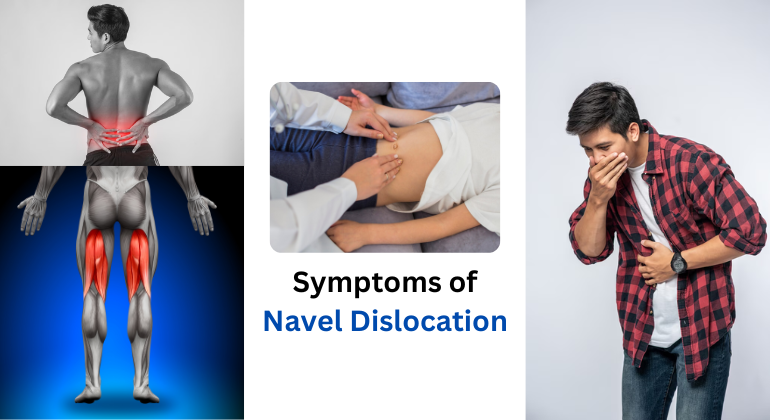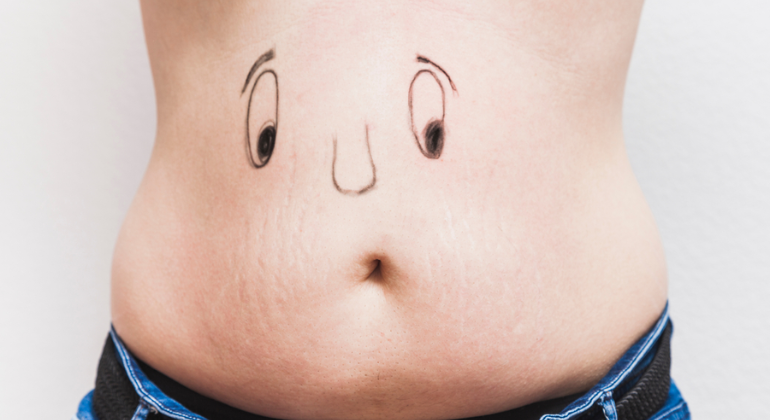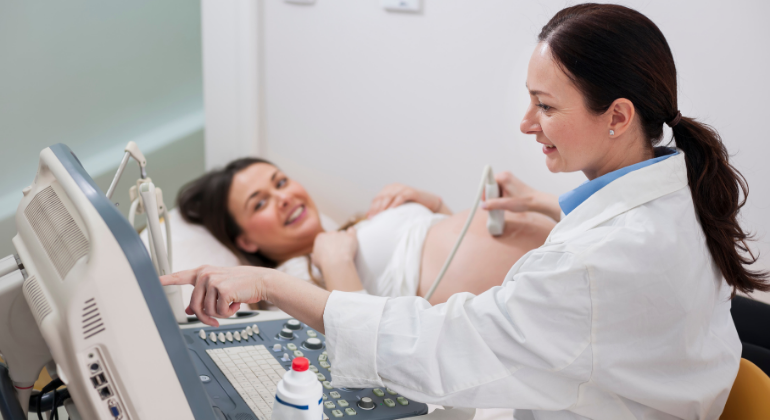Stomach pain, bloating, or a pulling sensation near the belly button can be more than just digestive discomfort—they may be signs of navel dislocation. This condition, where the belly button shifts from its natural position, can disrupt digestion, weaken core muscles, and affect posture. Often overlooked or mistaken for common digestive issues, navel misalignment can lead to persistent discomfort and long-term muscle imbalances.
Ignoring these symptoms might seem harmless at first, but untreated navel dislocation can contribute to recurring pain, poor digestion, and even restricted movement. Over time, it can weaken the abdominal muscles, strain the lower back, and impact overall body alignment.
The good news is that navel dislocation can be corrected naturally. With targeted techniques, core-strengthening exercises, and lifestyle adjustments, you can realign your navel, restore balance, and prevent future misalignment. This guide covers everything you need to know about the causes, symptoms, and effective natural remedies to keep your digestive and muscular health in check.
What is Navel Dislocation?
Navel dislocation, also known as navel misalignment or belly button shift, happens when the belly button moves slightly up, down, or to the side from its original position. This misalignment can cause discomfort and affect digestion, muscle function, and overall body balance.
Who is at Risk?
While navel dislocation can happen to anyone, some people are at a higher risk due to certain lifestyle habits or medical conditions.
- People who lift heavy objects incorrectly – Weightlifting or lifting household items without proper technique can strain the abdominal muscles.
- Individuals with weak abdominal muscles – A weak core provides little support to keep the navel stable.
- People with chronic digestive issues – Frequent bloating, gas, or constipation can put excess pressure on the abdominal area, leading to navel displacement.
- Postpartum women – Pregnancy and childbirth stretch and weaken the abdominal muscles, making navel misalignment more likely.
- Athletes or workers who perform sudden movements – Bending, twisting, or jumping suddenly can cause the navel to shift.
Can Navel Dislocation Be Fixed?

Yes! Navel dislocation can be corrected with:
- Abdominal massage to help reposition the navel.
- Yoga and core exercises to strengthen abdominal muscles and prevent future displacement.
- Lifestyle changes like improving posture, following a gut-friendly diet, and staying hydrated.
What Causes Navel Dislocation?
Several factors can contribute to navel dislocation. Some of the most common causes include:
1. Sudden Twisting or Bending
Fast movements, such as bending, twisting, or getting up quickly, can put stress on the abdominal muscles, causing the navel to shift out of place.
2. Lifting Heavy Objects Without Core Support
Lifting weights, heavy groceries, or other objects without engaging the core muscles can cause abdominal strain, leading to misalignment.
3. Digestive Problems
Chronic constipation, bloating, and excess gas can create internal pressure in the abdomen, which may shift the navel’s position over time.
4. Pregnancy and Childbirth
During pregnancy, the abdominal muscles stretch to accommodate the growing baby. After childbirth, these muscles may remain weak, making the navel more prone to misalignment.
5. Stress and Anxiety
High levels of stress can cause tightness in the abdominal muscles, which may contribute to navel displacement.
Prevention Tip: Always engage your core when lifting, avoid sudden movements, and eat a diet that supports digestion.
Symptoms of Navel Dislocation

Navel misalignment can cause a variety of symptoms, many of which are often mistaken for other digestive or muscular issues.
- Abdominal Pain – A dull or sharp pain near the belly button or lower abdomen.
- Bloating and Gas – A feeling of heaviness or excessive bloating after eating.
- Irregular Bowel Movements – Alternating between constipation and diarrhea.
- Visible Navel Shift – The belly button appears higher, lower, or slightly off-center.
- Weak Core Muscles – Difficulty bending, standing for long periods, or engaging in physical activity.
- Lower Back Pain – Poor posture and instability in the abdominal muscles can contribute to lower back discomfort.
If you experience two or more of these symptoms regularly, your navel may be misaligned and should be checked.
How to Check if Your Navel is Displaced?
If you suspect navel displacement, you can perform a simple at-home test to check for misalignment.
Self-Test for Navel Dislocation
- Lie down on a flat surface and relax your stomach muscles.
- Take a deep breath and gently place your fingers on your belly button.
- Press lightly around the navel area. If it feels higher, lower, or off-center, it may be displaced.
- Check for pain, tightness, or discomfort when pressing on the surrounding muscles.
Extra Test: Have someone mark the center of your navel while lying down. Stand up and check if the position has changed. If it appears shifted, your navel might be misaligned.
Best Natural Treatments for Navel Dislocation
If your navel is out of alignment, here are some effective home remedies to bring it back to normal.
1. Abdominal Massage for Navel Realignment
A gentle belly massage can help ease tension and reposition the navel naturally.
How to Do It:
- Apply warm mustard or coconut oil to your belly button.
- Massage in circular motions for 5–10 minutes.
- Take deep breaths to relax your stomach muscles.
Doing this daily before bed or early in the morning can improve digestion and prevent further displacement.
2. Yoga for Navel Alignment
Certain yoga poses help strengthen abdominal muscles and bring the navel back into position.
Best Yoga Poses:
- Pavanmuktasana (Wind-Relieving Pose) – Helps release gas and bloating.
- Naukasana (Boat Pose) – Strengthens the lower abdominal muscles.
- Bhujangasana (Cobra Pose) – Stretches and realigns the navel.
Practicing these 3–4 times a week can help maintain proper alignment.
3. Strengthen Your Core to Prevent Future Misalignment
A strong core provides better support for the navel and prevents misalignment.
Try these simple exercises:
- Planks to stabilize abdominal muscles.
- Leg raises to improve lower belly strength.
- Pelvic tilts to help maintain navel alignment.
Start with 5–10 minutes a day and gradually increase intensity.
4. Ayurvedic Remedies for Navel Stability
Ayurveda recommends natural treatments to improve digestion and abdominal strength.
Effective Ayurvedic Remedies:
- Drink buttermilk with black salt to reduce bloating and gas.
- Consume ajwain (carom seeds) with warm water for better digestion.
- Apply warm castor oil around the belly button to relax muscles.
Using these along with massage and exercise can speed up recovery.
5. Stay Hydrated & Eat a Gut-Friendly Diet
Good digestion is essential for maintaining navel stability.
Best Foods for Gut Health:
- Fiber-rich foods like fruits, vegetables, and whole grains.
- Probiotics like yogurt, kefir, and fermented foods.
- Hydrating drinks like coconut water and warm herbal teas.
Avoid spicy, fried, and processed foods, as they can increase bloating and discomfort.
Final Thoughts
Navel dislocation is common but often ignored. If left untreated, it can lead to stomach pain, weak digestion, and posture problems. Thankfully, it can be corrected naturally with simple home remedies.
- Massage, yoga, and core exercises can help realign your navel.
- Ayurvedic remedies and a proper diet support healing.
- Good posture and hydration prevent future misalignment.
Try these remedies, and if symptoms persist, consult a chiropractor, physiotherapist, or Ayurveda expert for professional help.
Recent Blog : How to Identify Navel Dislocation: Signs and Symptoms
Frequently Asked Questions (FAQs)
Kya navel dislocation bar-bar ho sakta hai?
Haan, agar aap core muscles strong nahi rakhte ya baar-baar heavy lifting galat posture mein karte ho, toh nabhi ka bar-bar hatna ho sakta hai.
Prevention ke liye:
✔ Regular yoga aur core strengthening karein
✔ Heavy objects uthate waqt core engage karein
✔ Sudden movements avoid karein
Kya navel dislocation khud se theek ho sakta hai?
Kuch mild cases mein, navel thoda relax hone par apne aap align ho sakta hai, especially agar stress ya gas pressure ki wajah se hua ho.
Lekin agar pain, bloating, ya weakness continue ho rahi hai, toh massage, yoga aur Ayurvedic care lena zaroori hai.
Kya navel misalignment fertility ya pregnancy pe effect karta hai?
Direct effect nahi hota, lekin weak abdominal muscles aur digestion issues reproductive system ko indirectly affect kar sakte hain.
Post-pregnancy women mein navel misalignment common hota hai. Isliye postpartum abdominal recovery exercises zaroori hote hain.
Kya navel dislocation ke liye koi test ya scan hota hai?
Normally, clinical tests ya scans required nahi hote. Ye mainly physical symptoms aur manual examination se detect kiya jata hai.
Agar doubt ho, aap physiotherapist ya chiropractor ke paas jaa sakte ho jo belly button alignment test karte hain.
Kya tight kapde ya belt pehnne se nabhi displace ho sakti hai?
Haan, tight jeans, belts ya shapewear se abdomen pe extra pressure padta hai jo nabhi ki natural position ko disturb kar sakta hai.
✔ Loose aur comfortable kapde pehniye
✔ Especially after meals, tight waistline avoid karein
✔ Belly ko relax aur free rakhna digestion aur alignment dono ke liye accha hota hai







